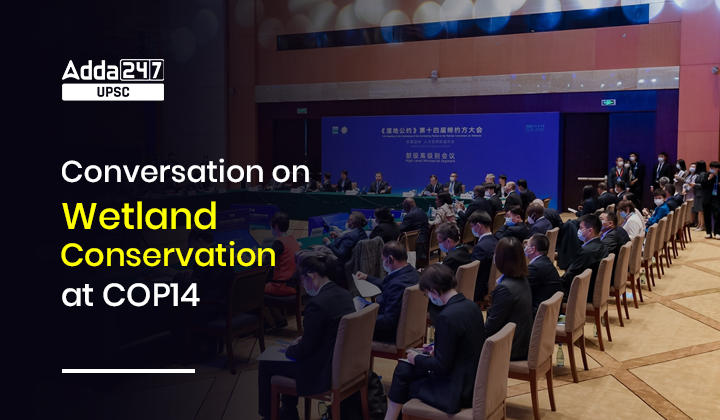Table of Contents
Why we are reading this article — Conversation on Wetland Conservation at COP14?
This article — ”Conversation on Wetland Conservation at COP14” is related to Wetland Conservation under the recently held ”COP14 Convention on Wetlands” and it will explain to you about the Conversation on Wetland Conservation at COP14 and India’s approach to wetland conservation. This will be helpful to cover the Environmental section for the UPSC Civil service exam.
What is COP14?
- COP14 took place between 5 and 13 November, with the physical meeting in Geneva, Switzerland. The high-level activities were led virtually by China. The theme of COP14 was ‘wetland actions for people and nature’.
- World Wetland Network(WWN) played an active role in it.
- An important part of COP14 was directed towards the Convention of Parties to the Ramsar Convention, or Ramsar COP, the large meeting that happens every three years.
- This COP14 Convention on Wetlands was aimed at — calling for action for people and nature.
- COP14 closed with the Parties adopting 21 resolutions to enhance wetlands action for people and nature.
How environment and wetlands are an integral part of the Cultural Ethos of India?
- India believes and practices compassion, service to fellow beings, sharing and social justice. Our environment has been a major part of our culture.
- Festivals like ‘Sarhul (Jharkhand)’ or Telangana’s Bathukamma, celebrate nature which helps us thrive and supports life. This nature is also the basis of bread for many – fishers, tourist guides etc.
- Among other benefits, wetlands are also important for the survival of floral and fauna.
- Several threatened migratory birds come to Indian wetlands. It provides wintering ground to migratory waterbirds such as the endangered Pallas’s fish-Eagle, the vulnerable Common Pochard, and the near-threatened Dalmatian Pelican, Grey-headed Fish-eagle, and Ferruginous Duck.
What is India’s approach to wetlands conservation?
- Rapidly upscaling wetlands conservation with stakeholder engagement through ‘Mission Sahbhagita’ and mainstreaming wetlands in development planning are core to India’s approach for wetlands conservation.
- The progress made by India in respect of designating 75 Ramsar Sites during the 75 years of independence is such an example as India added 11 more wetlands to the list of Ramsar sites to make a total of 75 Ramsar sites covering an area of 13,26,677 (ha) hectares in the country in the 75th year of Independence.
Why Conversation on Wetland Conservation at COP14 was important?
- Wetlands are of utmost importance for the ecosystem, given they maintain the global water cycle acting as natural filters to purify water; are the most efficient carbon sinks on the planet; protects us from natural disasters stabilising shorelines during storms.
- Furthermore, wetlands also absorb water to reduce floods and droughts.
- They are the most biodiverse ecosystems and are home to 40% of global species.
- According to studies, wetlands are nature-based solutions for achieving the Paris Climate Goals, Global Biodiversity Framework, and Sustainable Development Goals.
India’s efforts for Wetland Conservation
- India nearly has 4.6% of its land as wetlands that cover an area of 15.26 million hectares.
- The Indian Government launched the ‘Wetlands of India’ portal in 2021 for providing a single point for accessing all sorts of information relating to the wetlands.
- The Wetlands of India portal has been developed under a technical cooperation project “Wetlands Management for Biodiversity and Climate Protection” (Wetlands Project) of the Ministry of Environment, Forest and Climate Change (MoEFCC) in partnership with Deutsche Gesellschaft für Internationale Zusammenarbeit (GIZ) GmbH.
- Similarly, India has been taking several wetland conservation projects to restore and protect the important wetlands in India that are the basis of living for many.
4-pronged rejuvenation of wetlands projects
- The Ministry of Environment, forests, and climate undertook the restoration and rejuvenation of 130 wetlands under a four-pronged strategy, in which the nodal officers of these wetlands were trained in preparing focused management plans and in working out the health of the wetland.
- For the first time in the country, wetlands were graded between A to E as per their health.
COP14: FAQs
Q. What percent of India’s land are wetlands?
Ans: Nearly, 4.6 percent of India’s land are wetlands that cover an area of 15.26 million hectares.
Q. How many Ramsar Sites are there in India?
Ans: India recently added 11 more wetlands to the list of Ramsar sites to make a total of 75 Ramsar sites covering an area of 13,26,677 (ha) hectares in the country.
Q. What was the theme of COP 14?
Ans: The theme of COP14 was ‘wetland actions for people and nature.’




 TSPSC Group 1 Question Paper 2024, Downl...
TSPSC Group 1 Question Paper 2024, Downl...
 TSPSC Group 1 Answer key 2024 Out, Downl...
TSPSC Group 1 Answer key 2024 Out, Downl...
 UPSC Prelims 2024 Question Paper, Downlo...
UPSC Prelims 2024 Question Paper, Downlo...
